When it comes to learning a new skill, especially if that skill has to do with technology, I’ve found myself easily intimidated. Underwater photography definitely fell into that category for me, and from plenty of other people too, if my DM’s are any indication. 😉
I have wanted to learn to shoot underwater since I “dove” (sorry) back into photography in 2014, but I didn’t really know where to start! Last year, I decided to learn, and jumped in the deep end (heh) by booking a trip to Tonga to swim with humpback whales. The experience was amazing, and a fantastic first experience for me with underwater housing on my main camera body. Camera housing can feel bulky and a bit cumbersome, but you get used to it with time and practice.
I wanted to compile a basic beginner’s guide to underwater photography. This isn’t meant to be 100% comprehensive, but to cover the biggest questions I had personally while I was preparing and learning. Here are my tips for those who might be in the same boat (ok I’ll really stop now), and what I’ll be considering moving forward as I shoot underwater more.
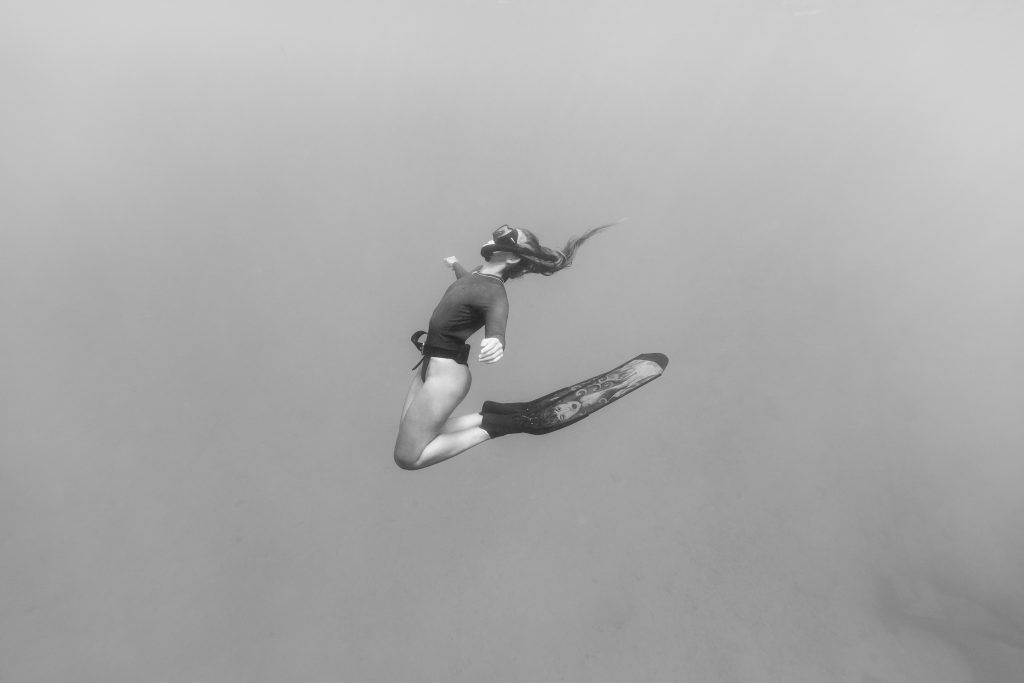
1. FIGURE OUT WHAT GEAR YOU NEED
First, let’s talk about your camera. What do you normally shoot with? What kind of images are you looking to get underwater?
Before getting into specifics for underwater camera housing, if you’re just looking for something that will do a decent job at capturing your adventures underwater, you can save lots of money by opting for a GoPro or a waterproof camera like the Sony RX0II. Keep in mind that these are wide-angle, and not necessarily the best for wildlife or macro. But they get the job done in many cases and may be worthwhile to consider, depending on your needs!
Another option is using a compact camera like the Sony RX100VII, and getting housing for it like this. Housing for compact cameras is smaller and less expensive, and it’s less bulky underwater. Make sure that the camera itself has a full manual mode, and that there is underwater housing available for it in the first place.
Overall, I found that it’s unavoidably expensive to get into underwater photography. The cost of the gear adds up so quickly! I’d recommend considering your needs and thinking about what aspect of the experience or the result is important to you, and go from there. There isn’t a one-size-fits-all answer. I ended up choosing Ikelite housing with a dome port for my Sony a7RIII and 16-35mm f2.8 lens. Since I was only shooting in shallow water, I didn’t use strobes, but for low-light or Scuba diving, look into these.
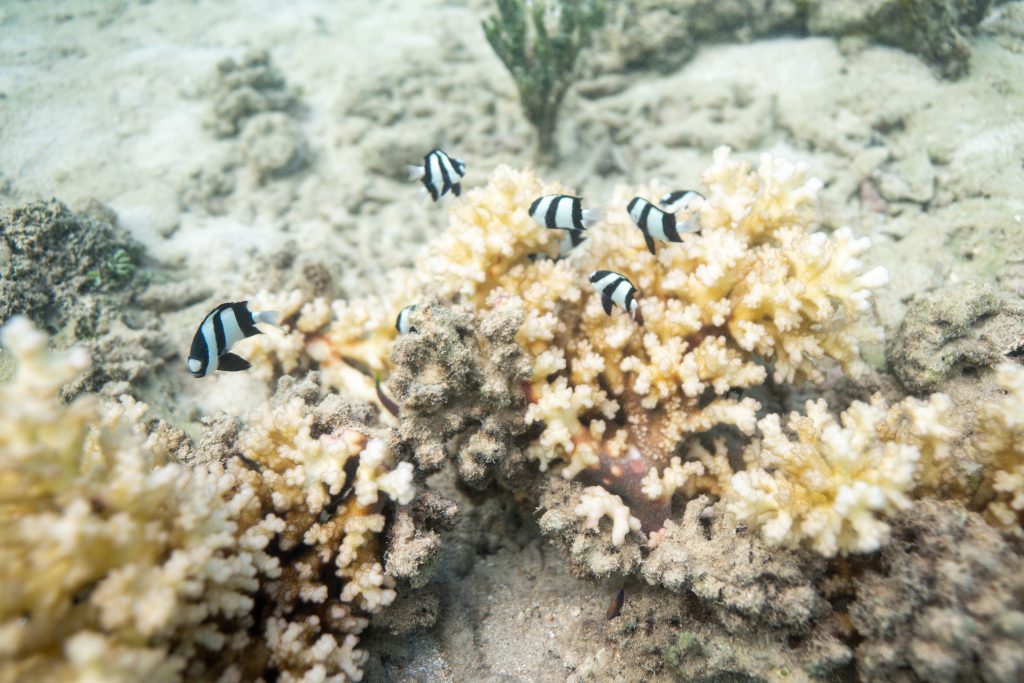
Let’s talk about housing. Underwater camera housing is a watertight case that holds your camera. Unless your camera itself is waterproof, you will need housing.
Surf housing is made for surf photography and shooting closer to the surface. It is made to be lightweight and withstand the waves. Surf housing units do not have much button functionality on the back panel, which means you can’t change many settings in the water. Brands include AquaTech, Liquid Eye, and SPL.
Diving housing is made for going deeper, and has more button functionality so you can change settings underwater. It’s also bigger, heavier, bulkier and can get pretty darn expensive with all the extensions, ports, and strobes. Brands include Ikelite and Nauticam. Generally more expensive than surf housing, though of course there are exceptions.
One part in particular worth pointing out: the port is the part of the housing where the lens goes. Underwater, a flat port will result in a zoomed in image (usually not ideal). A dome port will avoid this, as it accounts for the refraction of the water. A dome port also allows you to get over/under shots (bigger dome = easier to get those types of shots). Depending on the housing unit, you may have to order the port separately, so it is good to know which kind to look for. The housing manufacturer should have some kind of documentation listing the extensions/ports that fit certain camera and lens combinations. Be sure to get all the parts needed for the camera & lens you are wanting to use.
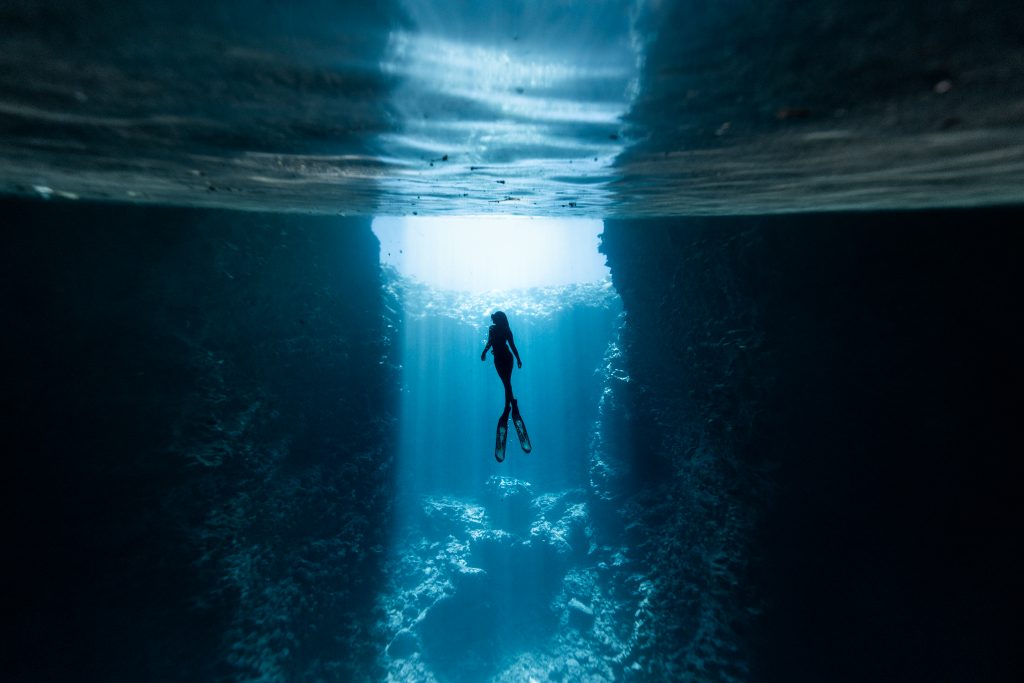
What about a mask, snorkel, fins and wetsuit? You probably need at least some of these items, and will want to buy backups if you are planning on going somewhere remote! The gear you buy totally depends where you are going and when, and of course, your budget. When it comes to buying a mask, the important thing is that you get something that fits your face. The best thing to do is go to a dive shop in person to try on masks, and to make sure you get a good seal. Snorkels can come with a few bells & whistles; some have valves to prevent water from getting in during wavy conditions. I bought a couple of flexible snorkels (with valves) from a local dive shop when I bought my masks.
There are plenty of fins on the market, varying in length, weight, and color. Find something that fits you well, and ask lots of questions in the dive shop. My fins are negatively buoyant, meaning they don’t float. There are also tons of wetsuits available in different styles and thicknesses to account for water temperature. When shopping for a wetsuit, be aware that neoprene is not particularly environmentally friendly–– it is often made using petroleum (unless it is specifically limestone-derived neoprene, and even that is nonrenewable). If this matters to you (I hope it does), buy from companies that prioritize eco-friendly practices. Patagonia makes Fair Trade Certified wetsuits from renewable natural rubber, and may be worth considering.
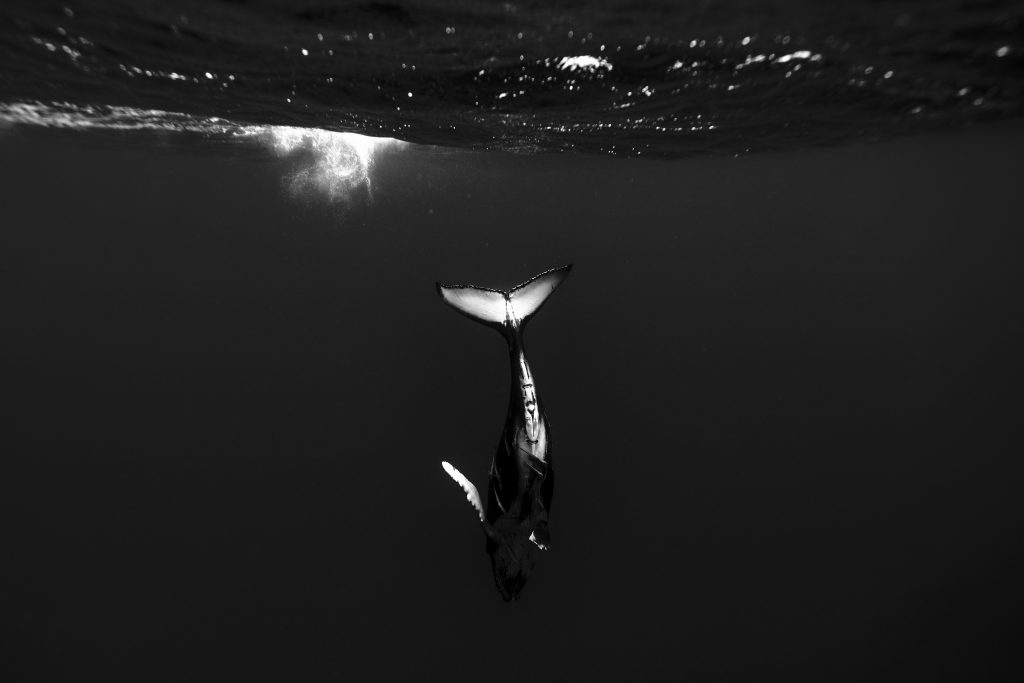
2. LEARN YOUR GEAR
Upon opening the box of my Ikelite housing, I felt like I was looking at a robot that I had to assemble. Luckily, it got easier. This is one situation where you should definitely read the manual and follow the directions that come with the product! Set aside some time and be patient. It’s easier than putting together IKEA furniture.
With my camera in the housing, I felt like I was learning how to use a whole different device. The buttons I was accustomed to using were all in slightly different places, and it felt like a different camera altogether at times. I took on the mindset that I was learning a completely new craft, and it helped me tremendously along the way. Giving myself a clean slate from which to learn from was very helpful.
In putting together my housing for the first time, I learned that one of the most important parts of my set-up was also one of the smallest: the O-rings. O-rings are rubber rings that seal the housing together, preventing water from getting in. They have to be lubricated with special lubricant (the brand matters). If the O-rings get dirty with something like sand, hair, or lint, a gap can form which could cause flooding.
I’m lucky to have a specialty shop (BlueWater Photo) where I live, and the specialist there told me that there is some debate when it comes to O-ring strategy. He, an avid diver, uses a kind of “set it and forget it” method, where he sets up his O-rings at the beginning of the trip and then tries not to mess with them much. When I was in Tonga, I cleaned and re-lubed my O-rings a couple of times. Whatever method ends up working for you, the #1 rule is to take care of your O-rings!
You also want to have a good understanding of how to change the camera battery, should you need to do that on the water. My Ikelite housing required that I detach my lens in order to access the battery compartment (very inconvenient). I did find that with more practice, I learned how to do this more quickly and with less fumbling.
Once you’re ready to try out your housing in water, submerge your housing in your bathtub (with no camera in it at first) and see if you get any bubbles. Afterward, inspect the housing and see if any fog develops, which is a sign of a leak.

3. CHANGE YOUR SETTINGS
Part of this is personal preference, but I’m going to share the settings I used.
I always shoot RAW, and for my trip to Tonga, I shot on Shutter Priority mode most of the time, set at 1/400 sec. I set my ISO to Auto, with a maximum of 6400. I used Continuous Auto-Focus, and used a Zone Focus Area. I set the burst mode to the middle setting. I use back-button focus so that my focus button is separate from my shutter.
What do all those settings mean? They mean that the camera prioritized the shutter speed first, and adjusted the aperture and ISO to make up for that. I find that the Continuous AF is pretty good at shooting what I want it to on the a7R III, but it would occasionally focus on the particles floating in the water, so I always shot multiples to be safe.
If you shoot mirrorless, you need to turn off the Electronic Viewfinder so that the screen is always on (that’s what you’ll see underwater). This uses more battery, so I made sure to only have my camera on when I was actually using it.
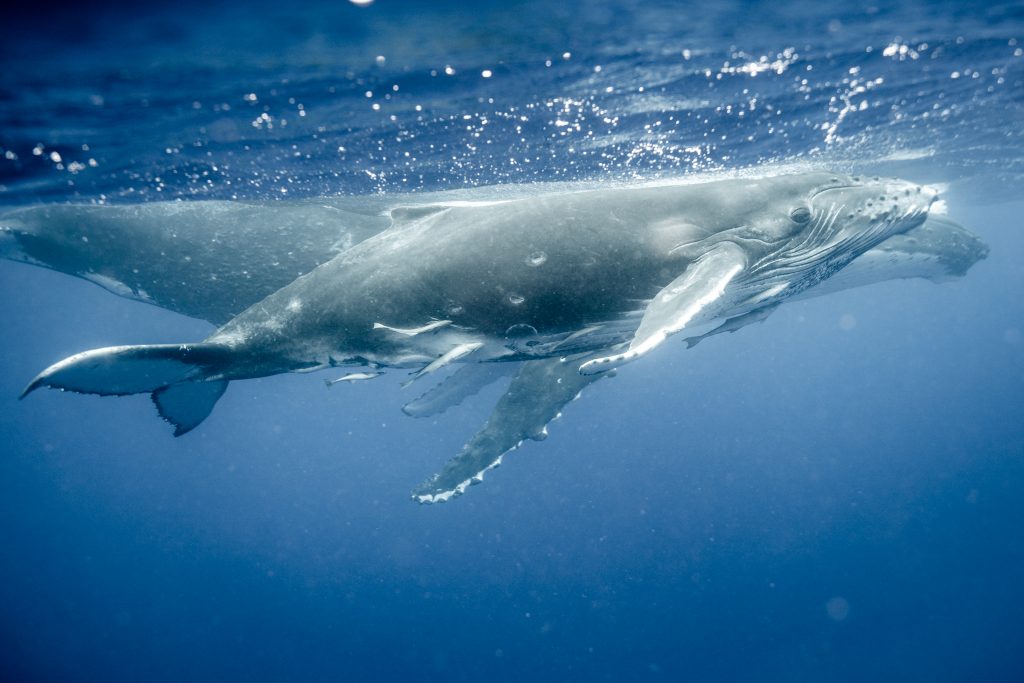
4. PRACTICE
There’s only so much you can learn in your bathtub. Eventually, you have to get in the water with your gear. And it will be terrifying the first time. I was so paranoid when I actually used my underwater camera housing underwater. You know, for its intended purpose and everything. 😂
When you’re shooting underwater, it will probably feel like there is just… a lot going on. You’re breathing out of a snorkel or regulator, or maybe you’re holding your breath, and you’re wearing fins, and you might be fighting against your own buoyancy… there are just more factors to think about than when you’re on land. It might be awkward. Remember, you’re learning something completely new! Embrace a beginner mindset.
On one of my first swims with my housing, I had my friend Charyse model for me. I also worked on diving down to get closer to different sea life. It was helpful to have a variety of subjects to play with. Going on a few practice swims was very helpful and helped me feel more prepared once I got in the water with the whales. I was able to get comfortable with my settings on my practice swims, and develop muscle memory fairly quickly.
Keep in mind that the light, water, and weather conditions are not always going to be ideal. Work with what you’ve got, and make sure to treat the water itself as a subject too. You can create beautiful shapes with just the water and the light. Remember that art is experimental! Play with the water as it moves across your lens.

5. POST PROCESSING
One difference you’ll notice between your underwater photos and all the others, is that the white balance is particularly wonky. Though it is possible to capture a near-perfect raw image, there will usually be a blue/green tint to your images. Get super familiar with the white balance panel in your editing software (I use Lightroom). You also find it beneficial to adjust colors individually in the HSL panel, especially Blue and Aqua.
Editing my underwater shots, I found myself hitting some of the sliders pretty hard! Depending on the water clarity, the weather, the depth and the light, you may have a lot or only a little editing to do.
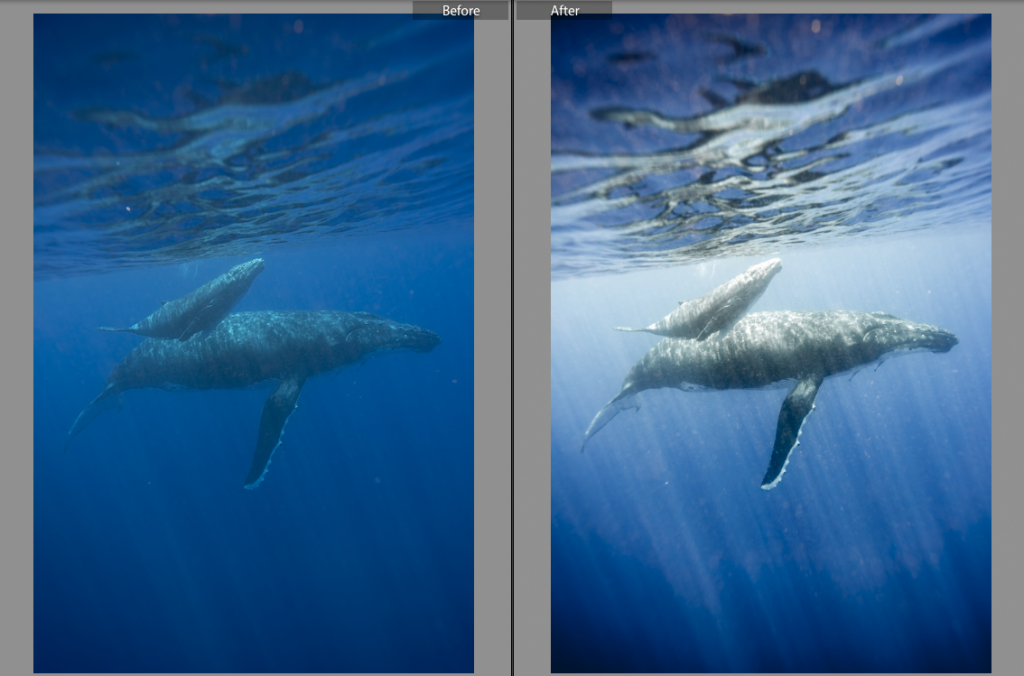
My first experience with underwater photography was ridiculously fun. Of course, I was swimming with whales, and that’s a bucket list experience in and of itself! But beyond that, having a new way to practice my craft was very refreshing. If you have the opportunity, even if it just means borrowing a friend’s gear and getting in the water for 20 minutes, I’d highly recommend it.
Throughout this learning process, I found that preparation is key. I am typically someone who jumps and builds the plane on the way down, meaning I figure it out as I go. This is not a situation where I’d recommend that! Not knowing how to work your housing could result in destroying your camera gear! Make sure to take the time to understand the basics of how your gear works before you leave for a trip.
Underwater photography may feel daunting. My advice? Let it be fun! Don’t beat yourself up if you don’t understand your housing right away, or if you aren’t nailing your first edits. You’re learning a new craft. Let your previous knowledge of photography help you out instead of judging yourself for not being perfect right away.
If you have any resources to add, comments that expand on any of the above, or questions, feel free to leave them in the comments below. Hope this was helpful!
FURTHER READING & RESOURCES
- Getting Started with Underwater Photography – Dive Photo Guide
- Photographing Marine Life with a Surf Setup – Dive Photo Guide
- Best Underwater Cameras for Beginners – BlueWater Photo
- How to Take Photos Underwater – National Geographic
- How to Take Underwater Photos – PetaPixel
- Underwater Photography Tips for Beginners – AquaViews
- Beginner’s Guide to Underwater Photography Equipment – AquaViews
- Underwater Photography: Five Tips for Beginners – The Wandering Lens
- Underwater Cameras & Housings at B&H
Please ignore this text box - Recoleta Font
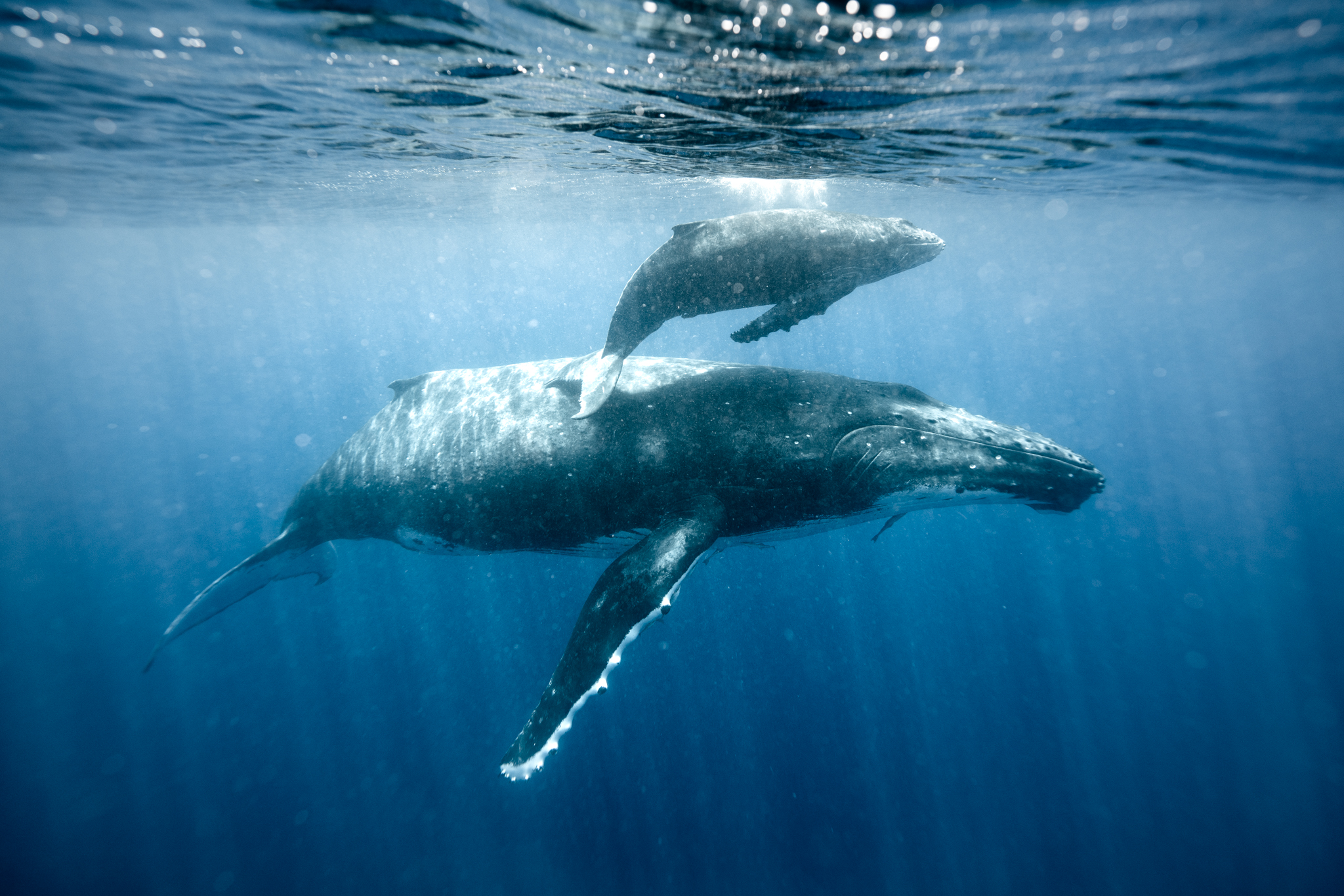
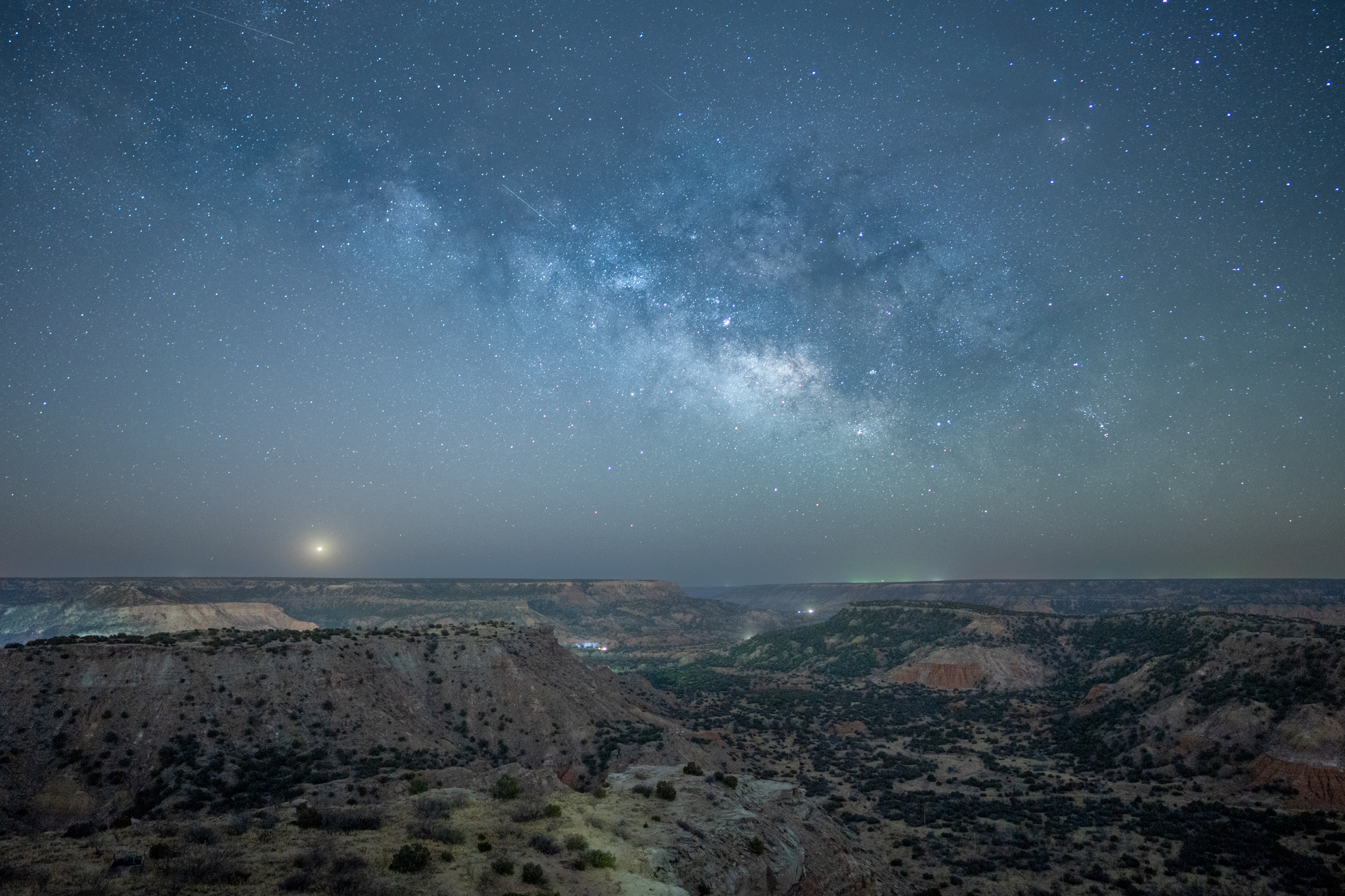


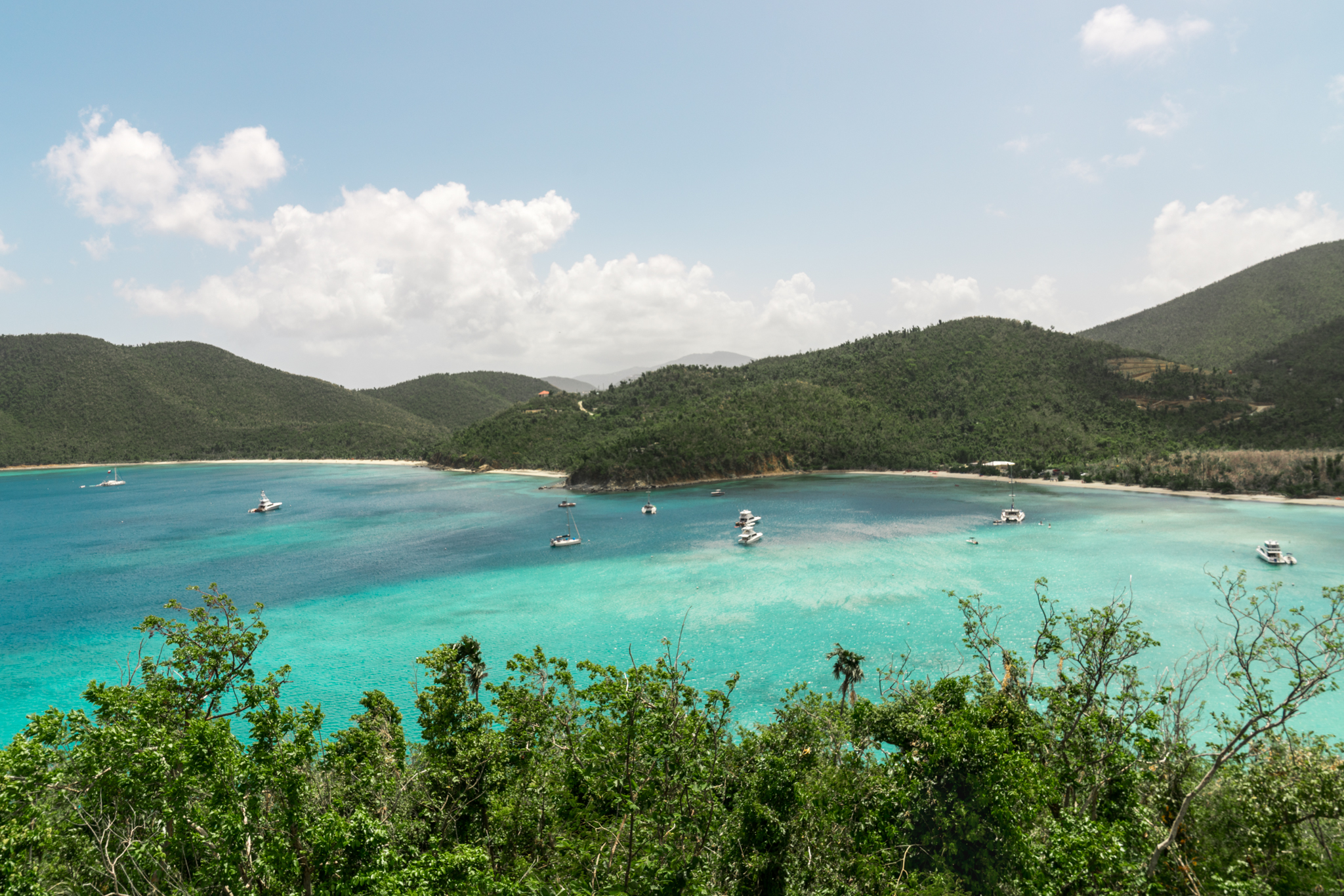
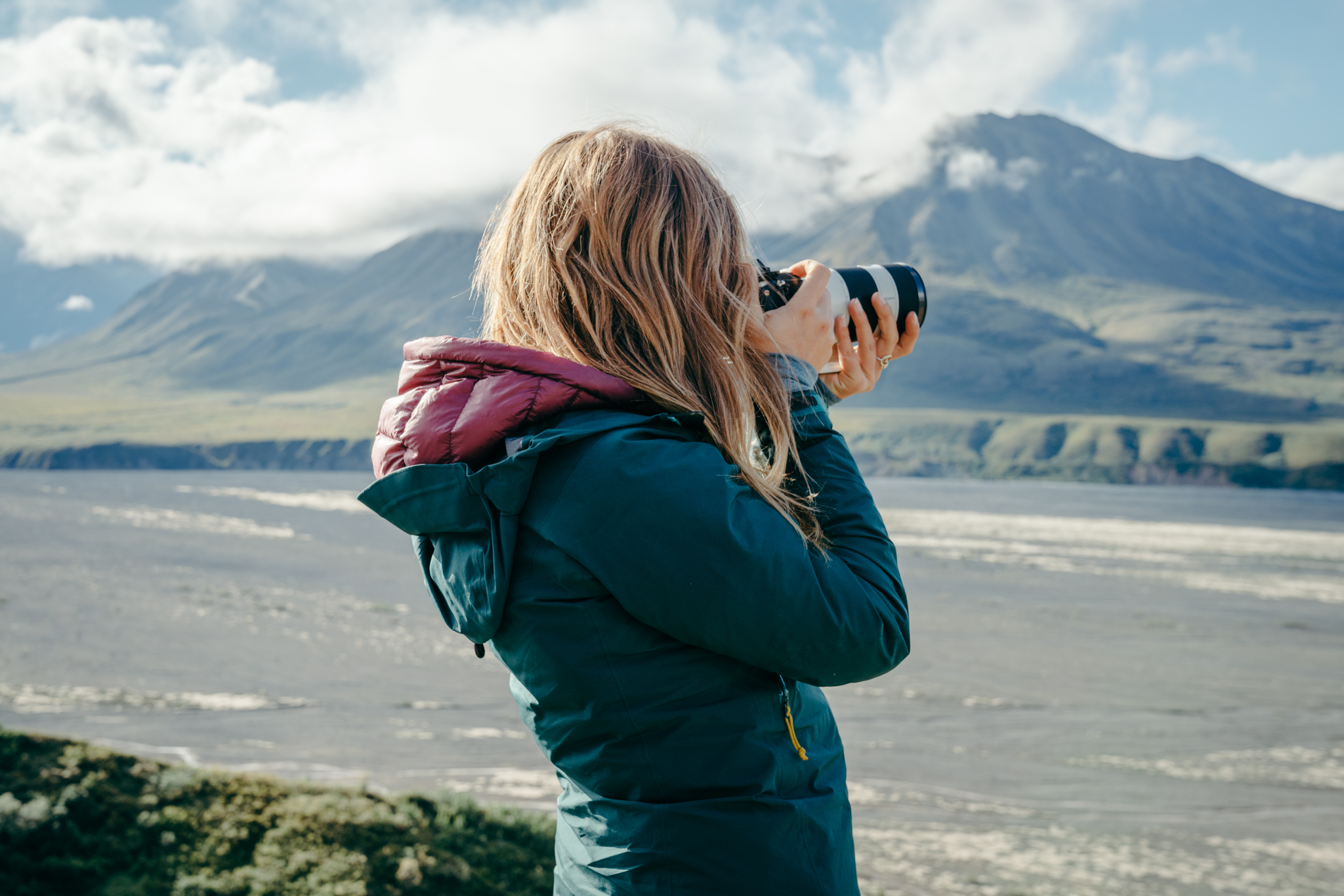
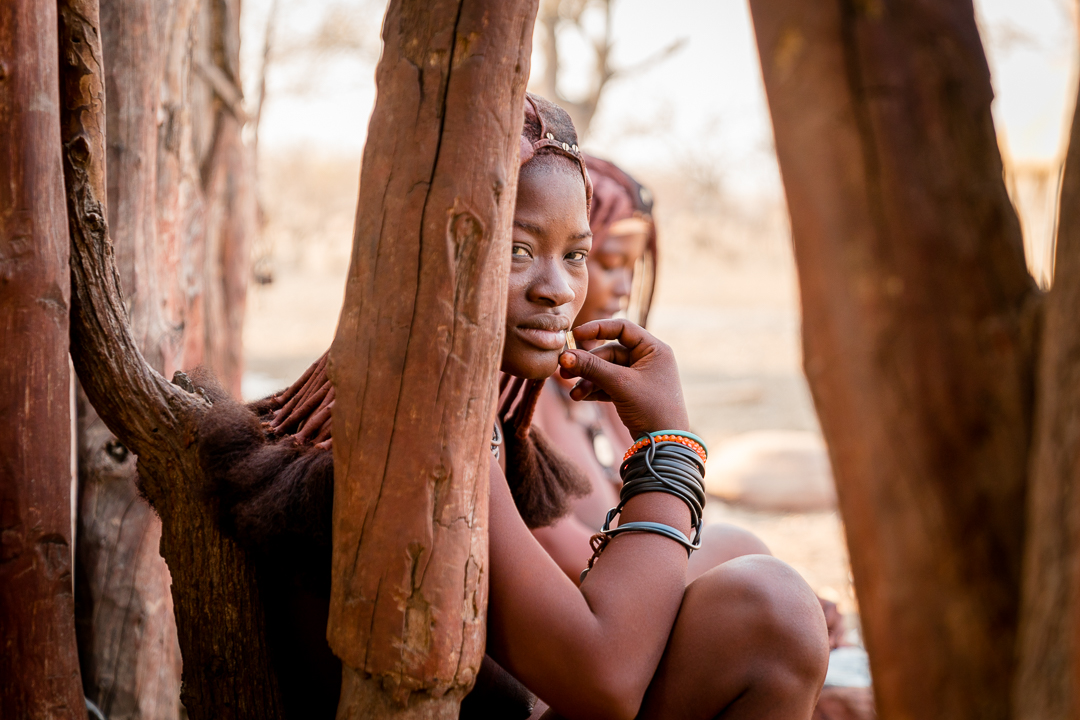
This is the first post that I have seen which is very inspiring, I got a lot of the latest inspiration from here, do you need to create a blog like this so that other people can also get ideas and if I am allowed to continue following you? May I ask for your telegram so I can get notifications of your latest posts?
Will bookmark this as a reference point before purchasing anything from my local stores or online like ###anythinghere###!! hvac wholesaler lubbock
Your take on puppy training is fantastic! I also recommend checking out dog training for more tips
Awesome article! Discover more at https://df999.fish/
Christian and his team absolutely saved the day after my kitchen remodel was botched by another contractor. They fixed his shoddy work, finished the job and even finished some other little nagging things around the place office renovation contractors near me
Very useful post. For similar content, visit abogados Coruña
Great points made about local businesses needing better security measures—visit TreeStone Security Services for
Can anyone share their experience with hydroseeding on clay soil? I’m curious if it works well there! Visit Residential hydroseeding for
Facing a legal challenge? Don’t panic! Explore the support offered at https://list.ly/regwanxuvr regarding bail bonds
Kualitas produk di https://anicadelanna62.contently.com tidak perlu diragukan lagi
Having conversations around mental well-being tied into physical health especially concerning dentistry needs more attention!!!! Let’s open discussions!!!! ### anyKeyword cosmetic dentist frisco
I’m amazed by how easy it was thanks to **moving company** services from **Las Vegas**: **### anykeyword ###** Las Vegas moving company
Carlsbad Roofing Contractor has a team of skilled professionals who are trained in the latest industry techniques and standards. Rest assured, your roof is in capable hands residential roof installation
I’m amazed by the transformations in these CoolSculpting before and after photos. It’s reassuring to know there’s a non-surgical option available coolsculpting lubbock
Me encanta cómo la Santa Muerte une a personas de diferentes culturas. Es un símbolo de esperanza y protección santa muerte hip hop artists
I recommend emergency locksmith wallsend for anyone needing mobile locksmith services—they were so helpful during my
Great tips on maintaining healthy skin! I always look for new products that can help Barnsley beauty treatments
Have you ever tried chiropractic care in Lakewood? I found a great Lakewood Chiropractor that helped relieve my back pain
I wish I had known about these dental options years ago! Fantastic post! winnipeg dentures
You’ve made a compelling case for making use of an authenticator app; I’m convinced it’s a necessity now! https://jsbin.com/
I’ve been comparing prices of different copiers copier sales
Excellent job explaining both sides of using a professional versus self-bailing out!! domestic violence bail
Basement design can be a game changer for homeowners looking to increase their living space. Lucas Remodeling offers fantastic ideas that blend style with practicality. Their portfolio showcases amazing transformations that could spark your imagination Basement Renovation Lucas Remodeling
Bagong Player? Mag-sign Up sa https://stake-ph.com – stake Para sa Libreng $100 Bonus!
Wow, I didn’t realize how often clogs can happen! Regular apofrakseis will be part of my new routine
I never thought about the long-term effects of water damage until reading this Fire Damage Restoration Olympia
Restoration services can be pricey, but knowing how to handle minor water damage yourself can save you money! Check out Soot cleanup Lacey for DIY tips
Thanks for sharing these tips—looking into regular # https://wiki-byte.win/index.php/%CE%A4%CE%B1_%CE%9F%CF%86%CE%AD%CE%BB%CE%B7_%CF%84%CE%B7%CF%82_%CE%95%CF%80%CE%B1%CE%B3%CE%B3%CE%B5%CE%BB%CE%BC%CE%B1%CF%84%CE%B9%CE%BA%CE%AE%CF%82_%CE%91%CF%80%CF%8C%CF%86%CF%81%CE%B1%CE%BE%CE%B7%CF%82_%CF%83%CE%B5_%CE%A3%CF%8D%CE%B3%CE%BA%CF%81%CE%B9%CF%83%CE%B7_%CE%BC%CE%B5_%CF%84%CE%BF_DIY # has never been more
Has every person experienced frame contouring at a Frisco med spa? I’d want to recognize extra approximately it! Med Spa Frisco TX
This topic is so relevant for homeowners in our area Mold Remediation Olympia
It’s great to have found this article. Rarely do you see so many valuable tips on how to choose a white label SEO provider https://list.ly/glassalvum
So many excellent points made here—I’m inspired by your content αποφραξεις
Such an informative post! I’ve been meaning to schedule some φθηνές αποφραξεις at my house for a while now
Withdrawal sa https://bk8-ph.com – bk8: Madali at Secure na Proseso para sa Lahat
This is exactly what I needed to read! Pest issues can be overwhelming, but knowing about Renton Pest Control gives me peace of mind Renton pest control services
Wow, I had no idea bed bugs were such a big issue in our area! Time to contact Renton Pest Control for an inspection Pest control Renton
Na [bet 7k](https://bet-7k.com), o atendimento ao cliente é confiável e sempre acessível. Com suporte online 24/7, você pode esclarecer dúvidas ou resolver problemas a qualquer momento. A equipe profissional está comprometida em oferecer um serviço de qualidade para garantir sua tranquilidade na plataforma.
Insightful read on conversion rate optimization—if you’re serious about growth marketing agency near me
La conexión entre el arte y la veneración de la Santa Muerte es muy rica; hay obras increíbles al respecto novena encendida a la santa muerte
If you’re into gourmet edibles dispensary las vegas
I appreciate the tips on how to improve indoor air quality with HVAC systems. Very informative! For additional resources, check out 24 hour AC repair
Auto detailing is this kind of sport changer for automotive homeowners in Oregon City—notably propose investing in it! Ceramic Coating Oregon City, OR Vortex Detailing
Ưu đãi hấp dẫn như thế này chỉ có ở RikVIP thôi rikvip
I really enjoyed this post! Plumbing issues seem to pop up when you least expect them Affordable plumber
If you’re looking to boost your engagement on Instagram, finding the best place to buy Instagram poll votes can make a huge difference. It’s crucial to choose a reliable source to ensure quality interactions ways to fake votes in instagram stories
I appreciate all the information on VA loans—it’s such an important subject for our veterans Memphis mortgage lender
Landscaping with rocks adds such character! Discover unique ideas at landscaper sarasota
The business model of salon suites is fascinating—it’s all about empowering beauty professionals! Dive deeper at salon suite rental
My gaming console was acting up, and YUFixit Mobile Repair fixed it quickly how to recover data from iPhone
”Couldn’t be happier reminiscing past adventures taken earlier alongside friendly faces met throughout travels shared together W private driver
Let’s all support companies that prioritize sustainability in their operations! More info at https://gravatar.com/delicately5379448505
Love the data shared right here! A stable online presence is principal for fulfillment in Houston’s competitive market – Custom website design
Have you thought to be how an awful lot dirt builds up over the years? Thanks to # GreaseKleen House Washing League City #
Best part about it? No hidden fees whatsoever just straightforward pricing without surprises tampa bouncer
Just complete my emergency treatment qualification via CPR Course Adelaide , and I really feel a lot more confident managing emergencies now
Exploring different clinics for CoolSculpting—found some great leads through coolsculpting results amarillo
From SEO to social media web design and development solutions
Great job! Discover more at obtener más información
Does anyone know how the Puyallup Heat Pump compares to traditional heating systems? I’m trying to weigh the pros and cons before deciding what to do next Air conditioning repair
Fantastic post! I learned a lot about energy efficiency and how an electrician can help with that. Discover more at electrician
This is a striking assessment of on-page search engine optimization techniques! I’ve compiled extra insights at off-page SEO methods
This web publication has solidified my awareness of the importance of preventive measures opposed to rodents—thank you back!!## anyKeywod homemade bait for DIY rat control
I hadn’t conception about how pets should affect rodent presence until examining your article—nice point of view!!## anyKeywod application guidelines for rat poison
TANGGAL77 ✈️ Daftar Bandar Pkv Games Dan Agen Pkv Resmi Terpercaya
I love how secure and reliable 8k8 is for online gambling
I always feel safe playing at 8k8 because of their strict security measures
It’s great to see more dental practices focusing on holistic health! I believe our oral health is connected to our entire well-being affordable cosmetic dentist in Sherman Oaks
Really enjoyed diving deep into specifics surrounding various models analyzed comprehensively outlining strengths weaknesses has aided underst boiler installation
Thanks for the insightful write-up. More like this at https://www.mixcloud.com/ruvorndrzw/
Houston has several of the very best locations to get engagement rings! Whether you choose classic designs or even one thing much more modern, there’s most definitely one thing for everybody engagement rings houston
a href=”https://crystaliteinc.com/”>toto togel
saldo5d
link toto
toto togel
toto togel
Great article! I had no idea that finding a reliable roof contractor in Carlsbad could be so easy. Thanks for sharing this valuable information roofing contractor quotes
Sometimes it takes courage step outside comfort zones embrace unknown explore realms possibilities await discovery excitement unfolding time revealing opportunities waiting embrace wholeheartedly Janitorial Services Scottsdale AZ
Đừng bỏ lỡ cơ hội tham gia vào những sự kiện hấp dẫn tại rik vip nhé!! ##rik vip## rikvip
.As we continue navigate complexities surrounding evolving l los angeles malpractice law firm
Tham gia vào cuộc thi thú vị trên Game bài đại gia của Topzo nào! ##topz0## topzo
If you’re in Maryville and need exterior cleaning, I highly recommend Pressure Washing Company
You’ve made this topic easy to underst gutter companies Jacksonville FL
Well explained. Discover more at ##Oracle Law Firm## Newport Beach Personal injury lawyer
If you want complete peace of mind regarding your safety needs Tucson AZ security services
This was a great article. Check out phim sex không che for more
“The expertise of professionals in this field cannot be overstated; reach out to them today: affordable stump grinding service
Have questions about gutter systems? Answers are just a click away on roofing contractors
. Establishing community awareness events focused on safe driving practices makes a positive impact—let’s organize efforts through # anykeyword auto accident attorney
La música y las canciones dedicadas a ella reflejan su impacto cultural tan profundo oraciones de amor a la santa muerte
Went to a ##Puyallup Chiropractor## last week Puyallup Chiropractor
Just wrapped up a beautiful deck installation thanks to the crew from Midwest Construction and Remodeling—I can’t wait to use it all summer long! Learn more about their offerings at siding contractor
API quota exceeded. You can make 500 requests per day cambridge house cleaners
I’ve recently stumbled upon an old favorite of mine Bibamax
It’s important to choose the right service for roofing needs roofing consultation
If you’re ever in need of a tow professional emergency towing
Understanding your target audience better has helped me create content that resonates with them, leading to more visits! Find out how at website for a new business
Explore the new and exciting updates at Vivamax that never fail to amaze me vivamax sex scene
Great Post!
. Indoor-outdoor living encourages connection with nature: what outdoor features complement interiors nicely ? professional Florida interior designer
Cabo provides the perfect putting for a dream wedding ceremony with amazing shorelines, luxury venues, and educated distributors top-rated photographers in Cabo
The concept of streaming Vivamax Movies at no cost thrills me! I’m eager to see what Bibamax has in store! Bibamax
Planning to add a water feature to my garden—Greensboro has some lovely examples to draw inspiration from! landscaping greensboro
The idea of getting to watch Vivamax Movies for free is really exciting! I can’t wait to see what Bibamax has to offer! Bibamax
I am truly amazed by the fact that such valuable content is available for free—A heartfelt thank you to Bibamax for their generosity! Bibamax
Helpful suggestions! For more, visit contemplative photography ideas .
”Advice shared among peers utilizing this service constantly proves helpful during struggles encountered daily within industry landscape!” insurance leads
Your tips on choosing a chiropractor are spot on! I’ll be looking for a Northgate Chiropractor next week. Chiropractor Northgate
Well done! Find more at sex viet
Love my leased SUV! Perfect for circle of relatives highway trips and weekend adventures. suv for lease
Experienced an unforgettable film night thanks to the complimentary Vivamax Movies offered by Bibamax – it was such a delightful time! Bibamax
After analyzing your article, I’m satisfied that Botox is a incredible preference for declaring a youthful appearance! https://unsplash.com/@lolfurcphs
Nếu như những ai đang đọc comment này mà chưa từng thử thì hãy nhanh tay tham gia ngay hôm nay đi nào!!! # # # # cổng game Ricwin
It’s hard to believe that all this great content is available for free—thank you, Bibamax!! Bibamax
Free streaming has completely transformed the way I watch films! Bibamax
I’m truly excited about the diverse bold content – it genuinely elevates my viewing journey! Bibamax
Thank you for this informative post! Time to book some apofrakseis athina at my place!
Such essential factors addressed during discussion today—to think we often neglect what could easily lead us down unexpected paths involving costly repairs stemming from untreated #ourhome# situations… αποφράσεις αθήνα ειδικοί
Truly enlightening content presented here—I’m eager now more than ever before planning out those necessary scheduled appointments focused solely around implementing quality ####myhome# solutions. αποφράξεισ στην αθήνα
With great anticipation, I am ready to delve into more courageous material from the wonderful platform, Bibamax! Bibamax
Watching bold and entertaining content has never been easier with Bibamax! Bibamax
Nicely done! Find more at best remodeling contractor Vancouver WA .
Loved reading this post—proper care like # apofrakseis # is essential for a healthy plumbing system!
Such essential factors addressed during discussion today—to think we often neglect what could easily lead us down unexpected paths involving costly repairs stemming from untreated #ourhome# situations… αποφράξεις
Love the focus on prevention here; regular # https://tiny-wiki.win/index.php/%CE%9A%CE%B1%CE%B8%CE%AC%CF%81%CE%B9%CF%83%CE%BC%CE%B1_%CE%BA%CE%B1%CE%B9_%CE%91%CF%80%CE%BF%CF%86%CF%81%CE%AC%CE%BE%CE%B5%CE%B9%CF%82:_%CE%9F_%CE%A4%CE%AD%CE%BB%CE%B5%CE%B9%CE%BF%CF%82_%CE%9F%CE%B4%CE%B7%CE%B3%CF%8C%CF%82_%CE%B3%CE%B9%CE%B1_%CE%9A%CE%B1%CE%B8%CE%B1%CF%81%CE%BF%CF%8D%CF%82_%CE%91%CE%B3%CF%89%CE%B3%CE%BF%CF%8D%CF%82 # can definitely save you from future headaches!
If someone has previously settled their claim but later experiences ongoing issues due to their initial injury workers compensation attorney near me
This is such an eye-opener regarding home care! Don’t neglect your drains, folks—schedule your αποφράξεις αθήνα !
permainan situs resmi dan mudah menang
profitable game register now to feel the sensation of becoming a millionaire
situs slot mania gacor mudah menang
permainan situs resmi dan terpercaya
toto togel 4d resmi
This is very insightful. Check out https://europharmvn.com/lutidha/ for more.
Surprised that there is no subscription cost whatsoever! Relishing this liberty on Bibamax .
As someone who enjoys variety above all else when it comes down selecting preferred gameplay modes- rest assured knowing there’s something suited perfectly onto every taste imaginable whilst navigating around #### rik vip ####! rikvip
I love how ##rikvip## offers both classic and modern games rikvip
Tổng kết lại rikvip
Nền tảng giải trí online Rikvip có gì đặc biệt? Mình sẽ tham gia ngay! rikvip
Với giao diện đẹp mắt , dễ sử dụng rikvip
Every visit feels like an adventure as we uncover hidden treasures tucked away inside each corner of these shops; explore along with us over on Guitar trade-in
Incredible article about making spaces look their best through photography—reach out to # expert property photo services # for help too!
We’re your go-to local shop for embroidery, rhinestone apparel, and custom merch in Austin. rhinestone shirts austin
I’m making an allowance for upgrading my rig with an AMD processor; any suggestions? Help me out at Informative post !
Why do people neglect their trees until it’s too late? A little trim goes a long way—check out reputable tree removal company !
slot mania gacor
bandar togel toto slot 4d
Thanks for breaking down common plumbing issues so simply! Great read! cost of sewer pipe installation
Why settle for strange whilst you can pass dune buggy riding in one of many most captivating places on the planet, like Dubai? Excited for my upcoming day trip—information at quad bike dubai !
Have you considered planting new trees after removing old ones? It can rejuvenate your space! detailed tree health reports
I currently outfitted a PC with an AMD processor, and it runs like a dream! Check out my construct details at Discover more here .
Tea creates such a lovely atmosphere at home! How do you set up your perfect tea nook? https://unsplash.com/@merianioar
Sipping a cup of herbal tea before bed helps me relax so much! Any recommendations for bedtime blends? https://gravatar.com/automaticrunaway04630b0be5
I’m always looking for organic teas. Any brands you swear by? https://www.storeboard.com/ElvaMazzocchi
Is it worth paying someone to do your taxes, or should I take a DIY approach with online tools instead? most reviewed tax assistance
Liked your guide on how to choose the best plants for shady locations! It has opened brand-new possibilities for my garden style. More plant selection tips await at lawn care .
”Innovation doesn’t happen overnight takes dedication persistence hard work combined efforts contribute achieving greatness collectively amongst peers striving excellence no matter circumstances faced challenges encountered along way – let’s continue agent autopilot crm software
The importance of a good real estate agent cannot be underestimated. They can make or break a deal! For tips on choosing the right agent, check out gempark hai phong .
Nicely done! Find more at sex người lớn .
Experience the appropriate day on the water with our top rate yacht charters in Cabo. Cruise lovely coastlines, relish proper-tier service, and calm down in luxurious. Perfect for celebrations, sightseeing, or simply unwinding in paradise Cabo luxury charters
Sanal dünyada görünürlüğünüzü artırmanın en etkili yolu: #takipçi almak! Detaylar burada: Korsan Taksi
I didn’t believe chiropractic care would assist a lot till I went to an Whiplash chiropractor Savannah after my accident– so satisfied!
If you’re looking for a great dentist in Mission Viejo, check out Saddleback Dental Associates! They provide exceptional care. dentist
The role of technology in managing supply chains is fascinating! A good wholesale grain supplier can leverage that, like wholesale grocery distributor .
The connection among natural and organic score and patron engagement within the magnificence enterprise is plain! Check out how one can get better it at seo for aesthetic clinics .
The travel itineraries provided on your blog are incredibly useful for first-time visitors! Website
Siento curiosidad por explorar si existen estudios universitarios o investigaciones formales sobre esto ### anyKeywo rd ## http://my-brilliant-blog-4548.mozellosite.com
Các bản phân tích kỹ lưỡng tại bocngalivem.blg giúp chúng ta hiểu rõ hơn về diễn biến từng trận đấu – bocngalivem.blg# 任何关键字# bongdaliveblog
Kudos once more noted – just can’t say enough good things regarding experiences had thus far!” # anyKey Word# bongdalive
Thanks for keeping us updated with real-time scores! I trust https://replit.com/@nguyenthuhuyenn completely.
Love how quick and effective some treatments can be—so convenient for busy schedules! More details on custom facials .
Useful advice! For more, visit Open Wide La Jola Dentistry .
Having peace-of-mind knowing reliable support exists post-installation ensures homeowners feel confident moving forward!: ## gas boiler edinburgh
High-quality property photography can truly make a difference in real estate marketing. property drone imaging
Banning Construction Inc. offers fantastic services. Their team is very skilled! construction management
“Fascinating insights about event-based marketing!” I’m eager to see how agencies such as Social Cali of San Jose create memorable experiences—check them out: SEO optimization techniques San Jose !”
This discussion on s666 has opened my eyes to new ideas and thoughts! See more here
The children’s activities available in Greensboro are impressive! What places do you recommend for kids? Find more ideas at greensboro windshield replacement .
Helpful suggestions! For more, visit imaginative web design .
Can someone recommend the best helicopter tour company in Dubai? I want an unforgettable experience! helicopter dubai
I recently started exploring SEO services in Singapore, and I must say, it’s fascinating how local businesses can leverage these strategies to enhance their online presence what is digital marketing singapore
Bosch ürünlerimin bakımını düzenli olarak yaptırdığım için hiç sorun yaşamadım! Bosch Yetkili Servisi
Yetkili servis sayesinde cihazlarım hep ilk günkü gibi çalışıyor! Bosch Yetkili Servis
The improvements in AMD’s structure are brain-blowing! It’s enjoyable to give thought long run technologies. Discuss it extra at Helpful site .
The creativity behind some game designs found in #6897Games# leaves me inspired as a fellow gamer myself — support indie creators here: **ANYKEYWORD**! https://6789games.wordpress.com/
I appreciate your focus on women in sports; it’s such an important topic that deserves attention! Check out women’s sports coverage at https://csgfc.hashnode.dev/csgfc !
Such great advice; I’m eager to check out all that ###aniyKeyowrd### has in store! Sports Blog
This was a great article. Check out The Bud Depot online store for more.
Bir kez deneyince vazgeçemeyeceğinize eminim!! Bosch Yetkili Servis
So happy I found Matrix Electric after moving to Mesquite! Their service has been exceptional every time I’ve called them. Matrix Electric
Great job! Discover more at nhà cái nổ hũ .
Artık başka marka düşünmüyorum çünkü benzer destek bulamam!! Bosch Yetkili Servisi
Bosch cihazlarım için tek adresim artık yetkili servis oldu! Koran Taksi
Great job! Find more at game bài uy tín .
Tận hưởng những giây phút thư giãn cùng với xibet sau một ngày làm việc mệt mỏi.
The right legal team can make all the difference in your car accident case; don’t hesitate to seek help! car accident legal advice
Couldn’t imagine trusting anyone else after seeing firsthand just what kind of results arise following service provided.# #AnyKeyWord # Anywhere Chimney Sweep Houston Insured & Bonded
This failure really opened my eyes to what goes into masonry pricing. It’s not nearly products! For further information, do not miss out on Masonry Contractor Near You in Salem .
Character skills and upgrades can change the dynamics of gameplay completely—how do you approach building your characters for success in combat scenarios within these worlds, join our discussion over on https://qiita.com/jilibond ####?
Valuable information! Find more at Abatello Design Center .
Sounds like a reliable service! I’ll be calling them soon. inspect chimney
I not ever theory promoting my dwelling may be so speedy and bother-free! Kudos to https://list.ly/buvaelaubs for his or her advantageous assets!
If you’re in Louisville KY and need garage door repairs, look no further than garage door repair near me !
Great insights! Find more at payday loans new orleans .
The landscape of IT support services is evolving rapidly, especially in the GTA. It’s great to see so many options available for local businesses! For more tips, check out small business IT Support .
The right marketing strategy can help sell your home faster. Explore effective techniques at selling a house with tenants michigan .
Curious whether repairs should be made before listing?? Expert opinions and recommendations await you here: selling a house as is in michigan
Corrective Spinal Care of Florida is the best chiropractor in Cape Coral FL, truly a life-changer!
If you’re searching for a chiropractor near me, Corrective Spinal Care of Florida is an excellent choice Best chiropractic care near me
I love how organizations like Malnutrition relief focus on empowering children through education and resources!
Looking forward to connecting with others who’ve undergone similar experiences surrounding ###! liposuction consultation
This is an enlightening piece! However, another angle on the topic could shed light on aspects not fully explored here. https://nohu90so.mypixieset.com/
These modern farmhouse trends have me dreaming about my future home —thank you for sparking my imagination ! # # anyKey # ## Interior Decorators
This discussion on 메이저사이트 추천 is timely! I’m eager to hear more recommendations from fellow bettors.
I came upon the preferrred fee for Car Rental Perth with Cheap Car Rental Perth . They have a wide array of motors to pick out from!
I’ve been exploring all-natural remedies for hair growth and stumbled upon some intriguing info. Do you have any type of individual experiences or referrals? Dive much deeper at natural makeup lighting !
Kids had so much fun with the bounce house we rented from bounce house rentals clearwater —highly recommend it in Tampa!
Nếu bạn đang tìm kiếm một nơi chơi cá cược an toàn, hãy xem xét các # https://topnhacaiuytin63.mypixieset.com/ # này nhé!
I recently uncovered tree service and their tree services are first-class! They changed my backyard completely.
This post is very informative! What do you recommend for teeth whitening at home? cosmetic dentist lincroft nj
I love how you emphasized the importance of flossing! It really does make a difference in keeping teeth healthy. nj prosthodontist
If somebody wants brief garbage removing, I noticeably advocate contacting ##RubbishRemovalNearMePerth### immediately! Reliable Perth Rubbish Removal
I switched to an AMD GPU just lately, and I’m so blissful with my determination! What do you think ofyou’ve got the present fashions? Join me at get more info .
This post really highlights the importance of comparing rates from different brokers. It’s crucial for getting the best deal! For more resources, check out invisalign .
The importance placed on communication styles between clients and their chosen realtor cannot be stressed enough; ensuring clarity leads to better outcomes—check out __ANYKEYWORD__for extra resources around this theme! experienced real estate agent Chattanooga
I had a amazing revel in with dumpster rental Jacksonville in Jacksonville, FL. The personnel was once pleasant and the pricing turned into very sensible!
Tea lovers, unite! Whether you choose black, green, or natural teas, you’ll discover something to suit your palate at trademama supplier directory .
I’m always trying to find unique candle layouts! Have you seen any kind of interesting shapes or styles recently? trademama wholesale suppliers
Your post inspired me to plan a road trip to Nashville soon! Looking for additional tips? Visit Luxury Travel Agent .
Thanks for shedding light on the trends in the 먹튀검증 industry! This information is invaluable. I’ll be checking out your site for the latest updates and tips.
The topic of 시알리스 구매 is so relevant today! Thanks for shedding light on it.
This was a wonderful post. Check out click here for more.
If you are dealing with persistent agony, chiropractic treatment could possibly be the answer you’ve gotten been shopping for! Learn greater at best chiropractor denver .
I’ve done some research on treatments, and I found that 비아그라 구입 has some promising reviews lately.
DBT insights have helped me embrace discomfort, rather than avoid it. What an amazing shift! Visit https://unsplash.com/@gabilejeao if you want more tips.
Hopefully, we can encounter breathtaking views while cruising around those glorious sand dunes!!!! dune buggy dubai
The testimonials about 시알리스 직구 are quite compelling! They really highlight its effectiveness.
Has anyone tried using 비아그라 구매 ? I’d love to hear personal experiences and how it worked for you.
I recently stumbled upon 꽁머니 and I’m intrigued! Where can I learn more? Maybe on 꽁머니 ?
What precautions should one take when considering 시알리스 구매 ? Your insights would be helpful!
I recently learned about the benefits of 비아그라 구매 for improving sexual health. Has anyone else tried it?
Is it primary prepare amongst aquarists to call all their pets, such as every single human being in greater faculties like tetras?# # any Keyword ## https://list.ly/wortoncuqs
How often do you deep tidy your bathrooms? I try to do my own when a month! house cleaners cambridge
What seasonal transformations do seasoned aquarists suggest making all through winter months mainly ?# # any Keywords## https://duburgs.gumroad.com
I can’t stress enough how luxurious accommodations elevate an entire trip—it transforms everything from mundane tasks into delightful experiences; let’s uncover our favorite stays together over ### Alpharetta cruise agent
It’s beneficial realizing there are dedicated specialists out there who certainly care approximately helping humans achieve stunningly exquisite skins notwithst Aesthetic Clinic Marylebone
Local knowledge is essential when hiring movers; find reputable names in Plant City via Plant City apartment movers .
The rich history behind copper crafting inspires my work—what stories influence your creations? Let’s chat about inspirations over on my site, visit me now: Custom Roof Vents !
Love these actionable tips! If you’re in the aesthetic field and need help with your digital marketing, visit seo for aesthetic clinics and consult with I DIGIT GROUP SEO Experts.
Your advice on checking references and licenses when hiring painters is invaluable—I’ll definitely use this guide moving forward! best professional house painting services
Anyone have experience with salt-free alternatives? I’ve been researching options on benefits of quality water treatment .
Anyone else obsessed with how professional and attentive the staff are? They truly care about your results—thank you,Mesgloan!!! #happyclient#beyondhappy#youguysrock##anythinglink# Aesthetic Clinic Marylebone
Easy to use interfaces can make a significant difference in exactly how effectively your group makes use of the phone system. Relieve of usage should be a top priority! Learn more at Business Phone Service .
I believe that every real estate goal can be achieved with the right plan and partnership in place. Let’s get started on making yours happen! property management company
I recently learned about the advantages of using 꽁머니 for investments! Discover more at 여기로 이동하십시오 !
More personal stories about using 비아그라 종류 could really help others who are hesitant or unsure about trying it.
Riding dune buggies in the Dubai desert was exhilarating! Thanks to dune buggy dubai for an amazing experience!
**Easy Booking Process**: The online booking system is user-friendly and straightforward. You can browse their extensive inventory, check availability, and secure your rentals in just a few clicks. ridgecrest bounce house rentals palm harbor
Appreciate the detailed information. For more, visit hire phone hacker for testing security .
We did a Q4 set up with SunPower, aimed for five-yr ROI however now yr 3 shows closer to 6. commercial sunlight seasonal pricing hinted at inverter hiccups—ours failed two times causing downtime. Weekend set up stored ops nevertheless, 0 construction lost https://list.ly/aspaidadcs
Filing for bankruptcy might seem like an overwhelming process, but it can provide a fresh start for those in severe financial distress. It’s essential to seek professional advice to navigate the complexities involved bankruptcy attorney York
The potential of AI in transforming traditional industries like insurance is incredible—Agent Autopilot is leading this charge! agent autopilot insurance automation expertise
This post raises crucial points about lead generation—I’m curious how much impact tools like Agent Autopilot can have on success rates in insurance sales? secure aca leads from agent autopilot
Thanks for highlighting the importance of workflow when designing kitchens—such useful information! affordable Florida interior designer
The humidity in Florida makes it critical to address any mold concerns promptly; check out Mold Mitigation Sarasota !
My newly installed ####window well covers#### are not only practical but stylish too; thank you ## egress installation near me ##!
Does anyone know if there’s a recommended age range for considering surgery with experts from Aesthetic Clinic London #?
Thank you for the tips on organizing spaces effectively! More organization hacks await you at Home Remodeling .
You made some great points about SEO for construction websites. It’s so important to be found online! I’ve been optimizing my site and sharing tips that might help others as well: responsive design for contractors .
The significance of a supportive ambiance in a treatment facility for addiction can’t be overstated. It really makes a change in recuperation.
I’ve seen mixed reviews about 비아그라. Has anyone tried 비아그라 구입 1위 사이트 and found it effective?
Lighting under cabinets can create such ambiance; what types of lighting have transformed your kitchens? kitchen remodel cost Tewksbury
This is such a valuable resource! Whenever I need custom prints, Booklet Binding Lexington is my go-to.
The blend of nutrients in hydroseed really boosts growth potential—it’s like giving your lawn a power-up! Read about it at Residential hydroseeding .
I love the convenience of mobile car detailing! It keeps my car looking brand new. Learn more at full detailing service .
I dealt with State Farm last year and struggled with their lowball offers. Using how much compensation personal injury texas helped me push for a $45K settlement. Anyone else find medical bills get overlooked too often in these claims? understanding how caps affect compensation Texas
Este conteúdo está excelente! Poucos sites oferecem conteúdo tão direto sobre comprar backlinks. Parabéns pelo trabalho! Já vou acompanhar o site para continuar aprendendo. Isso é o que falta na web. Já tem outros artigos sobre o tema? comprar backlinks seguros
Thanks for the suggestions on window display restoration! It’s advantageous to be aware of there are native authorities in Cape Coral. Pool Screen Repair
I’d trust no one else but Roof Inspection Cork for any future roofing needs!
I was surprised by how many people struggle with ED, but glad there are choices available like 비아그라 .
I recently had some work done on my dome, and I was struck by how crucial it is to pick the best people for the task. I highly advise doing your research and reading customer testimonials if you’re looking for trustworthy# #roofing organizations near me## roofing companies near me armstrongroofingservices.com
I these days had my lanai displays repaired, and it made any such difference in my backyard area. Highly advocate sorting out All Screening of SWFL! Screen Repair
Great job! Discover more at local exterminator services Chester .
The continual of decluttering is not going to be overstated! It’s mind-blowing how a whole lot house you unfastened up by letting pass of factors you don’t need. Excited to analyze more from Cleaning near me !
This was a wonderful guide. Check out winning at online pokies games for more.
Really valuable content here about preventive dentistry! Additional insights available at Dentist Port St Lucie .
Just got my nails done at a Springfield nail salon, and I’m in love with the results! The technicians were so skilled and made sure I was happy with everything. For recommendations on local salons, visit nail salon springfield !
I can’t recommend mlbb diamond recharge enough! The prices are unbeatable for MLBB top-ups.
I’ve been looking into options for concrete and epoxy floor in Waukesha, and I must suggest that I found adhesive flooring to be both durable and appealing Midwest Concrete Technologies Concrete Company West Allis, WI
I’ve noticed 꽁머니 promotions are popping up everywhere! How do you think they affect player behavior at online casinos? 꽁머니 텔레그램
“Every time I detail my car using techniques from do car dealership do car detailing , I’m amazed by the transformation!”
I’ve been using 꽁머니 for a while now, and it has completely transformed my gaming experience! If you want to know how, check out 꽁머니 사이트 .
Very useful post. For similar content, visit asheboro auto glass replacement .
Great insight into the importance of selecting the best floor vendor for your needs! Epoxy floor offers both strength and a modern end, making it a fantastic choice for both residential and commercial spaces Midwest Concrete Technologies Concrete Company Delafield, WI
I love how some rehabs in scottsdale contain artwork and track treatment into their methods!
Has anyone noticed improvements in their relationships after starting 시알리스 구입 ? I’d love to hear your stories.
The evolving panorama of casinos and iGaming is virtually exciting, specially should you recall how technological know-how is using this change https://unsplash.com/@cromlijffi
Enterprise graph analytics is real transforming how organisations sort out tricky grant chain challenges analyzing petabyte scale data using IBM.com
Mình đã thắng một số tiền lớn ở GA888 Casino! Thật tuyệt vời! ga888
Can you really profit from 꽁머니 in the long run? I’d love to hear some success stories! Found some inspiration at 꽁나라 .
Tôi cảm thấy an toàn khi chơi ở GA888 Casino, dịch vụ bảo mật làm tôi yên tâm hơn nhiều! https://ga888-vn.net/
These discussions on 2023 crypto traits are surprisingly insightful, fairly as we see how Ordinals and NFTs keep to reshape electronic possession and creativity Learn more
Goldco has without a doubt made waves within the Gold IRA area, particularly on the subject of simplifying the rollover approach. One natural discussion level is the transparency of their expenditures steps for establishing a gold 401k
I love how conversations approximately magnificent success charms and cultural symbols open a window into private memories and traditions which may another way pass neglected Global Traditions of Luck Analysis
The destiny of casinos and iGaming stocks is a captivating theme, surprisingly as science keeps to reshape the playing panorama Additional info
Enterprise graph analytics is extremely remodeling how enterprises deal with elaborate supply chain demanding situations https://0pvij.mssg.me/
Your guidance about neighborhood codes was eye-beginning; thanks for sharing that knowledge formerly heading over to Fencing company Vancouver WA Freedom Fence !
I love how conversations approximately useful luck charms and cultural symbols open a window into personal reviews and traditions that might another way move neglected https://allmyfaves.com/freaghgwsx
Always remember: knowledge truly IS power when navigating tricky waters following serious incidents like these unfortunate ones involving automobiles specifically positioned within respective contexts surrounding said events occurring repeatedly over time Accident Lawyer
Wonderful tips! Discover more at top brunch destinations Pittsburgh .
Extremely advise enrolling in a First Aid Course– it’s worth every minute spent! More details on First Aid Courses in Brisbane .
I lately went to a physician resort for some much-needed self-care, and I was pleasantly surprised by the procedures accessible facials near me
Fantastic post! Discover more at car window repair asheboro .
Your comparison between asphalt shingles and slate tiles was very enlightening—I can see why people might choose one over the other now! benefits of new roof installation
The importance of consulting a healthcare professional before trying 비아그라 cannot be emphasized enough!
The way 꽁머니 works is so intriguing! I’m excited to see how it will change the gaming landscape. For updates, check out 꽁머니 .
Useful advice! For more, visit top brunch restaurants Pittsburgh .
Nicely detailed. Discover more at Walters Barbecue Southern Kitchen .
The workforce at Aqua Knight is authentic and thorough. My roof has on no account appeared more suitable! roof cleaning and moss removal
Excellent article on airports transport! How many ease is a trustworthy airport car service provide for passengers? Planning ahead for a specialized aircraft shift saves both time limo rental Sarasota FL
What do you think about the sports teams in Charlotte? I’m a huge fan of the Panthers! cheap windshield replacement Charlotte
This post really helped me understand the relationship between user engagement and Google Maps ranking better! I explore similar topics at my site: Web Design .
This was an enlightening read; I need help from SEO Agency Lowell in Lowell, MA for my online marketing!
What’s your favorite slot machine game? I’ve found some great recommendations on casibomgirisguncel2025.com !
Great job! Discover more at experienced restaurant refrigeration experts .
I recently learned some amazing card tricks for blackjack from casibom giriş guncel !
The cocktail bars in Tribeca are exact-notch; where do you love to unwind after work? italian restaurants in Tribeca
Fantastic post! Discover more at Open Wide La Jolla Dental .
“Casino promotions can lead to great deals; keep an eye out and find updates on offers from ## casibomgirisguncel2025.com
Have you checked out the clearance section? Amazing finds await you at opening a new appliance store !
Particularly in extreme weather conditions, maintaining a pleasant domestic atmosphere is important. Regular# #hvac## upkeep hardly simply ensures optimal performance but can also extend the lifespan of your program AC installation
Growing your Instagram presence can be challenging, but purchasing poll votes is a smart strategy to drive engagement. I’ve tried a few services, and one stood out for its reliability and results Instagram story fake votes service
Finding the right aid has been key as I just began my quest for better health and fitness. Individual instructors can make a huge difference, mainly those who concentrate on women’s conditioning resistance training workouts
Thinking about a home upgrade? Our Sumner WA remodeling team specializes in stylish, functional designs that fit your lifestyle. https://jsbin.com/yafahozume
“My radiator has been acting up lately; looking for tips on how to maintain it better!” ## wrecker services
It’s great that there are more options like 시알리스 available today than ever before! Let’s discuss our favorites! 시알리스 구입
If you desire assistance with ##search engine marketing Perth WA##, determine to look for skilled specialists who be aware the native market dynamics. SEO Perth WA
I just relocated to Swindon, and I can’t emphasize enough how crucial it is to pick the best removal firm. The knowledge does affect the evacuation procedure. I discovered some excellent options after researching regional removals in Swindon https://jsbin.com/baquzalixi
It’s fascinating how hormone therapy can help balance mood swings and alleviate symptoms. I learned so much from this article! Visit https://jsbin.com/yinoqovuke for more details.
Every Mobile Legends participant must trust riding Manabuy for their recharge wishes. I’ve stored so much time and money since switching! Learn more at recharge mlbb now .
This blog has inspired my African adventure! I’ll definitely visit travel agent near me for more information.
After the job was complete, they took the time to walk me through what had been done and answered all my questions. Their transparency is commendable. Christmas Light Installation Services by Tampa Bay Pressure Washing
I’ve had combined stories with LootBar and IGGM, but it’s strong to comprehend that Manabuy comes out on major! Looking forward to trying it out via where to find cheap top-up ManaBuy .
Thanks to Manabuy, I’m saving a lot on my Mobile Legends costs! You may still truly examine their per month offers at mobile legends top up !
Every gamer demands to understand approximately Manabuy’s monthly recharge deals for Mobile Legends! Save payment at the same time playing the game. Visit mlbb top up fast for more!
If you or someone you know has been involved in a car accident in Kennewick, it’s crucial to consult a knowledgeable attorney. Don’t hesitate to reach out to a local expert! Kennewick Lawyer
I just relocated to Swindon, and the localized movers I used were wonderful. The removals service’s reliability and expertise helped to make the whole procedure stress-free and efficient swindon removals and storage
The best types of wood for fencing vary by climate; let’s discuss this further! More insights available at chain link fence installation .
Thanks for the unique comparability! It’s quality to listen that Manabuy has no hidden costs and supplies security measures. I’ll be by way of battle pass ManaBuy to get all started with my purchases.
Safety is so main whilst deciding to buy on-line, so I’m completely satisfied to peer that Manabuy prioritizes it. I’ll test out where to top up on ManaBuy for greater facts!
I love looking savings just like the one you talked about! Your contrast confident me to are attempting Manabuy first, and I’ll seek for greater tips at Additional info .
Have you ever tried ceviche as an appetizer before diving into your main course?! It’s refreshing and light; discover ceviche ideas on mexican restaurant
If you are eager about upgrading your place entertainment, you will have to truely touch Envision Low Voltage in Sanford, FL. Home Cinema Installation
So happy with my decision to go with Window replacement for my window project; they exceeded my expectations!
My confidence has blossomed seeing that my boudoir session with Lins Photo Studio—thank you most! boudoir photographer
Can’t wait to turn off these lovely photographs captured by lIns graphic studio – I’m beyond excited!!!## anykeyword ## boudoir shoot
Just started my journey with 시알리스, and I’m hopeful! Looking for tips on what to expect next! 시알리스 구매
Just topped up again on mobile legends cheap recharge and I’m always impressed with how quick it is!
Great insights! Find more at Tru Balance Pain Relief Clinic .
Great insights on the importance of Seo companies! It’s interesting how a well-structured Seo strategy does significantly effect a website’s visibility and traffic. Countless companies underestimate the power of optimizing their blog for search engines SEO
Collaborative partnerships among local businesses promoting unique packages utilizing Limos unearths exciting possibilities fostering community engagement significantly—what initiatives sprang forth recently!? Contribute fully today!: ###任何关键字### limousine services
Wonderful write-up! It’s interesting to see how quickly the Seo surroundings is evolving. Value Pr services are necessary for businesses looking to enhance their online occurrence and pull edible transportation startup SEO services
Has anyone had a bad experience with 꽁머니? I’m curious about the pitfalls before diving in myself. Found some warnings at 꽁머니 사이트 .
The kind in coat forms between puppy breeds is astonishing! Do you select short or long-haired canine? https://g3i7c.mssg.me/
Wonderful tips! Find more at personal injury attorney representation .
Can we take a moment to appreciate how beautiful these guitars look under stage lights?! What’s your stage setup like? Show us over at Les Paul Frets and Action !
What a watch-beginning article approximately roofing constituents! For Portland locals, Roofing Contractor supplies massive suggestions and expertise.
Had a wonderful experience with the team from Window Installation # during my recent home renovation.
I recently moved into a brand new apartment and mandatory a residential locksmith Melbourne. The staff at Melbourne Locksmith awarded properly lock installation & repair offerings.
For each person needing emergency locksmith Melbourne providers, I can’t advocate Melbourne Emergency Locksmith pros ample—they’re effective!
. Wondering if anyone else has tried out virtual consultations as alternatives lately instead going physically into shops??? hair salon
Your breakdown of state-by-state regulations at Guns: Pistols, Rifles, Shotguns & More is a much-needed guide for gun owners.
I love this topic! Looking forward to enhancing my link profile with quality backlinks from Buy high-quality backlinks .
I’m grateful for the contributions made by various authors featured on your site; they bring unique insights to discussions about guns. Pistol wholesalers & distributors
It’s encouraging to see platforms like Arms & Ammunition Dealers that address both sides of the gun debate thoughtfully.
Really enjoyed reading through this; it’s clear that quality backlinks matter, and I’ve found some good ones at Manual backlink service !
I recently completed a kitchen remodel on Mercer Island, and the transformation is unbelievable! It’s amazing how a new layout and updated appliances can completely change the feel of a home https://jsbin.com/befeyudovo
What should I expect during my first visit to a Bonney Lake chiropractor? https://privatebin.net/?bb24a6e40d7af780#BJF2KKXVdLJhFkXTp3vRtdJ1c7U1EWwP52PaB8hmSY6j
How often do you guys visit your dentist in Newnan? I’m trying to stay on top of my dental health! dentist 30265
It’s encouraging to see platforms like Firearms Accessories that address both sides of the gun debate thoughtfully.
Awesome post! I’ve been researching link-building strategies and will look into what Buy backlinks that improve ranking has to offer.
Awesome information here! For anyone looking to enhance their SEO game, try buying backlinks from Buy backlinks that improve ranking .
Thank you for providing a platform that encourages responsible discussions about firearms and their use, such as seen on guns for sale .
I found your article on self-defense laws at Popular Gun Dealers to be very informative and timely!
Awesome information here! For anyone looking to enhance their SEO game, try buying backlinks from Backlink packages .
I’ve after all found the ultimate website for topping up Genshin crystals at an competitively priced worth! If you’re interested, the following’s the hyperlink: best top up options on ManaBuy .
Thank you for sharing your knowledge! I’m eager to improve my site’s rankings with help from Buy backlinks for niche sites and blogs .
If you are tired of grinding for Genshin crystals, you’ve gotten to study this out. It’s a total lifesaver! top up on ManaBuy
I’m new to SEO and appreciate the clarity in your writing! Looking forward to using High DA backlinks for sale for my link-building efforts.
When it comes to kitchen remodeling in Sumner, we focus on smart storage, beautiful finishes, and long-lasting value. Remodel Company
Well explained. Discover more at HVAC duct cleaning companies .
Thank you for recommending Manabuy for Genshin crystal recharges! It’s continually positive to discover a dependableremember supply. I’ll be checking it out right now! where to find fast recharge ManaBuy
Thank you for advocating for safe storage practices through your content at guns for sale !
How do you determine the right price to charge for stucco repairs? This is such valuable information for anyone in the business! I’ll be sure to share this with my contact at Stucco contractor Fort Saskatchewan. expert stucco repair
The interviews with industry experts featured on Sports Air Guns, Airgun manufacturers, suppliers & exporters are a fantastic addition to the discussion.